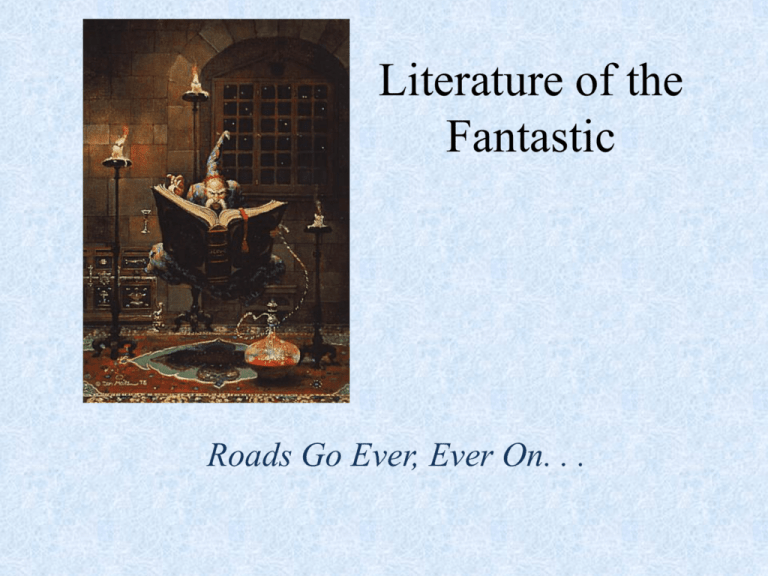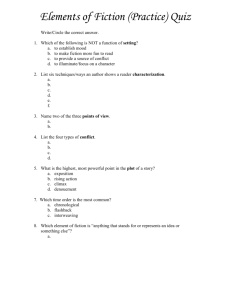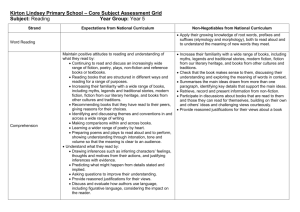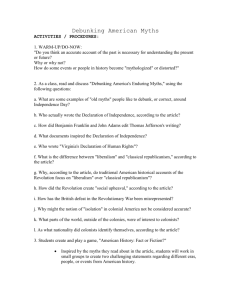Literature of the Fantastic
advertisement

Literature of the Fantastic Roads Go Ever, Ever On. . . Begins in Archetypes and the Formation of Myths • We start off with assertion that there exists in all of humanity certain patterns and types. • These archetypes if real were placed within our minds by God • Archetypes are the founding stone of dreams and myths. • Myths in this class are not classified as faulse but as attempts to try and answer the major questions of the human heart. The big questions • • • • • • Where Do I Come From? Why am I Here? Why Do I Do the Things That I Do? Can it be fixed Is there anything more? Where Am I Going? These myths shape narrative which is revealed in Literature: These Narratives are read by those who believe: • Homeric Hymns • Epic Poems, Iliad, The Odyssey and The Aeneid – (Not just Greek also Gilgamesh and Beowulf) • Greek Drama—The Bacchae Into the Middle Ages and the Renaissance • • • • • Medieval Romance “Wife of Bath’s Tale” The development of allegory The return of Drama in the church. Shakespeare: Hamlet, Macbeth, Midsummer Age of Reason ends a lot of the mythic fantastic narrative. – Bunyan's Pilgrim’s Progress-allegory – Swift’s Gulliver’s Travels is an exception but it is primarily a work of satire rather than awe. Still it is notable that this work was delegated into the realm of children’s literature because children loved it. The first flying saucer? “Laputa” is a flying island described in the 1726 book Gulliver's Travels Ghibli Studios came out a few years ago with a film about people trying to locate the legendary flying kingdom. • Important to remember that Christianity is the “True Myth” and so it shaped the narratives as well. It was the dominant one throughout the Middle Ages and the Reissuance. The Fantastic Among the Romantics • Expresses the belief of things larger • Affirms that reason is not the only gateway to truth • The wonder of the fantastic goes along with the wonder of nature • The particulars however unlike those of Shakespeare and Chaucer before him are no longer believed. Romantics Psychological • La Belle Dame sans Merci by Keats • Expression of the Archetypal destructive female – Personal rebellion against the pains of love. In Keats’ letters and in some of his poems, he reveals that he did experience the pains, as well as the pleasures, of love and that he resented the pains, particularly the loss of freedom that came with falling in love. – However, the ballad is a very objective form, and it may be best to read "La Belle Dame sans Merci" as pure story and no more. “Darkness” by Lord Byron • 1816 – The year without a summer—unusual weather caused by volcanic eruption • A scientist in Italy even predicted that the sun would go out on 18 July, shortly before Byron's writing of "Darkness". His "prophecy" caused riots, suicides, and religious fervour all over Europe • The whole poem can be seen as a reference to Matthew 24:29: “the sun shall be darkened.” • Apocalyptic Science Fiction Victorians • Rise of the Gothic tradition: "a piece of fiction in prose of variable length... which shocks or even frightens the reader, or perhaps induces a feeling of repulsion or loathing – Strange Case of Dr. Jekyll and Mr Hyde (1886) – Dracula (1897) • The rise of science and the loss of belief – “The Oxen” by Thomas Hardy: “So fair a fancy few would weave this day.” Speaking of a child’s Christmas tradition but connected in his mind with Christian faith. – Interesting that at the same times comes the Golden Age of Children’s lit as well as the first exclusive examples of Science fiction. The Golden Age of Children’s Lit • The delegation of the fantastic to children’s literature – Golden Age of Children’s Lit • Charles Kingsley’s “The Water Babies.” (1863) • Lewis Carroll “Jabberwocky” Alice in Wonderland (1865) • Influences on C. S Lewis and J.R.R. Tolkien http://youtu.be/g-Hmfkve3pQ “The Golden Key” by George MacDonald (1867) Then the Old Man of the Earth stooped over the floor of the cave, raised a huge stone from it, and left it leaning. It disclosed a great hole that went plumb-down. "That is the way," he said. "But there are no stairs." "You must throw yourself in. There is no other way." An clear image of faith. “The Reluctant Dragon” (1898) by Kenneth Grahame • The critic Peter Green, in his 1959 biography of Grahame, writes that while the story can be viewed as a satire like Don Quixote, the characters can be seen on a deeper level as representing different sides of the author himself: • St. George represents Grahame as a public servant who works for the Establishment while the Dragon, who would rather be writing poetry, represents his anarchic, artistic, and anti-social side. The point is that once again there is more going on in these narratives that one might at first believe. The key to this outpouring of especially fine children’s lit is that authors made a point of NOT being condescending. They wrote about real problems even when portraying them in fantastic ways. “Goblin Market” (1862) by Christina Rossetti • This poem can be read as a straight forward fairy tale. • Two girls Laura and Lizzie, are tempted to eat the fruit offered to them at the Goblin Market. • Laura gives in and finds herself unable to gain satisfaction. Lizzie must eventually save her. Although treated and presented as a children’s story, there are strong sexual undertones and passages to adulthood are suggested. Hellboy 2 featured a visit to the Goblin Market The Coming of Science Fiction • Speculative Fiction—if technology continues who does it affect individuals and society? • Types – – – – – Extraterrestrial Technilogical Dystopia Holocaust Post Holocaust • Classes – Hard Sci Fi • Nothing impossible – Soft Sci Fi • Whatever flies






